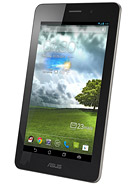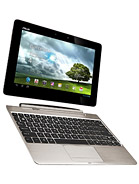
The latest creation rolling off the production line at Asus is the Asus FonePad: a 7-inch Android tablet that can make and receive phone calls.
Arriving with an extremely friendly £179.99 price tag when it launches on April 26, the FonePad is here to compete with the likes of the Google Nexus 7 (also developed by Asus), the Kindle Fire HD and the all-conquering iPad mini for your affections.
Interestingly, the Asus FonePad is notable for coming armed with an Intel processor rather than the Nvidia Tegra chips favoured by the majority of Android devices. The Intel Atom Z2420 on board clocks in at a speed of 1.2GHz and has a separate PowerVR SGX540 GPU for backup.
There's 16GB of storage space as well as the unbridled benefit of Android Jelly Bean arriving out of the box. But it's the smartphone aspect of the device that Asus is hoping will entice you.

It's not exactly wrong either. Once the 3.5-inch display of the iPhone 4S was considered sufficient, but the sales of devices like the Samsung Galaxy Note 2 and the recently revealed Samsung Galaxy Mega suggests we're getting happy with bigger screens.

It's an attempt to answer the age-old dilemma of one general device or multiple specific devices.

But Asus has tucked plenty of tech into the device and kept the price low enough that it certainly stands as a respectable tablet in its own right.

The Asus FonePad features the accepted 7-inch screen and, from the front at least, looks the conventional Android tablet.

The rear of the tablet has more in common with Apple's iPad mini than the Asus-produced Google Nexus 7 thanks to a smooth metallic finish. Available in either "titanium grey" or "champaign gold", the metal adds an undeniably premium feel even if the grip isn't as good as the dimpled rear surface of the Nexus 7.

The FonePad's 16:9 aspect ratio means its easy to grip around the back for anyone with small or medium sized hands. You'll be able to curl your fingers around the edge and hold it comfortably, rather than having to resort to holding it by one corner and obscuring part of the screen.

We mentioned that tablet manufacturers cut corners in the early days and some of that still survives - cost is cost, after all. The FonePad doesn't feature a rear-facing camera, so the back of the chassis is completely clean. By way of markings, you'll find an embossed Asus logo and the familiar Intel Inside mark at the bottom of the tablet.

The only two ports on the device are the micro USB port and the 3.5mm headphone jack. These are both found on the bottom of the tablet with the headphone jack to the left of the charging port.

If Asus does want to best Apple's effort, it can point to screen resolution as one way of doing that. The 1,280 x 800 resolution panel on the FonePad display benefits from an LED backlight with IPS technology and is exceptionally clear.

Unfortunately, the problem with premium metallic finishes and beautiful TFT-coated screens is the susceptibility to dust and scratches. It's no different here and the FonePad is certain to come off worse against keys and loose change if you leave it unprotected in your backpack. Our advice? Invest in a case.
There's 16GB of storage space as well as the unbridled benefit of Android Jelly Bean arriving out of the box. But it's the smartphone aspect of the device that Asus is hoping will entice you.

It's not exactly wrong either. Once the 3.5-inch display of the iPhone 4S was considered sufficient, but the sales of devices like the Samsung Galaxy Note 2 and the recently revealed Samsung Galaxy Mega suggests we're getting happy with bigger screens.

It's an attempt to answer the age-old dilemma of one general device or multiple specific devices.

But Asus has tucked plenty of tech into the device and kept the price low enough that it certainly stands as a respectable tablet in its own right.

The Asus FonePad features the accepted 7-inch screen and, from the front at least, looks the conventional Android tablet.

The rear of the tablet has more in common with Apple's iPad mini than the Asus-produced Google Nexus 7 thanks to a smooth metallic finish. Available in either "titanium grey" or "champaign gold", the metal adds an undeniably premium feel even if the grip isn't as good as the dimpled rear surface of the Nexus 7.

The FonePad's 16:9 aspect ratio means its easy to grip around the back for anyone with small or medium sized hands. You'll be able to curl your fingers around the edge and hold it comfortably, rather than having to resort to holding it by one corner and obscuring part of the screen.

We mentioned that tablet manufacturers cut corners in the early days and some of that still survives - cost is cost, after all. The FonePad doesn't feature a rear-facing camera, so the back of the chassis is completely clean. By way of markings, you'll find an embossed Asus logo and the familiar Intel Inside mark at the bottom of the tablet.

The only two ports on the device are the micro USB port and the 3.5mm headphone jack. These are both found on the bottom of the tablet with the headphone jack to the left of the charging port.

If Asus does want to best Apple's effort, it can point to screen resolution as one way of doing that. The 1,280 x 800 resolution panel on the FonePad display benefits from an LED backlight with IPS technology and is exceptionally clear.

Unfortunately, the problem with premium metallic finishes and beautiful TFT-coated screens is the susceptibility to dust and scratches. It's no different here and the FonePad is certain to come off worse against keys and loose change if you leave it unprotected in your backpack. Our advice? Invest in a case.
There's 16GB of storage space as well as the unbridled benefit of Android Jelly Bean arriving out of the box. But it's the smartphone aspect of the device that Asus is hoping will entice you.

It's not exactly wrong either. Once the 3.5-inch display of the iPhone 4S was considered sufficient, but the sales of devices like the Samsung Galaxy Note 2 and the recently revealed Samsung Galaxy Mega suggests we're getting happy with bigger screens.

It's an attempt to answer the age-old dilemma of one general device or multiple specific devices.

But Asus has tucked plenty of tech into the device and kept the price low enough that it certainly stands as a respectable tablet in its own right.

The Asus FonePad features the accepted 7-inch screen and, from the front at least, looks the conventional Android tablet.

The rear of the tablet has more in common with Apple's iPad mini than the Asus-produced Google Nexus 7 thanks to a smooth metallic finish. Available in either "titanium grey" or "champaign gold", the metal adds an undeniably premium feel even if the grip isn't as good as the dimpled rear surface of the Nexus 7.

The FonePad's 16:9 aspect ratio means its easy to grip around the back for anyone with small or medium sized hands. You'll be able to curl your fingers around the edge and hold it comfortably, rather than having to resort to holding it by one corner and obscuring part of the screen.

We mentioned that tablet manufacturers cut corners in the early days and some of that still survives - cost is cost, after all. The FonePad doesn't feature a rear-facing camera, so the back of the chassis is completely clean. By way of markings, you'll find an embossed Asus logo and the familiar Intel Inside mark at the bottom of the tablet.

The only two ports on the device are the micro USB port and the 3.5mm headphone jack. These are both found on the bottom of the tablet with the headphone jack to the left of the charging port.

If Asus does want to best Apple's effort, it can point to screen resolution as one way of doing that. The 1,280 x 800 resolution panel on the FonePad display benefits from an LED backlight with IPS technology and is exceptionally clear.

Unfortunately, the problem with premium metallic finishes and beautiful TFT-coated screens is the susceptibility to dust and scratches. It's no different here and the FonePad is certain to come off worse against keys and loose change if you leave it unprotected in your backpack. Our advice? Invest in a case.
| General | 2G Network | GSM 850 / 900 / 1800 / 1900 |
|---|---|---|
| 3G Network | HSDPA 850 / 900 / 1900 / 2100 | |
| SIM | Micro-SIM | |
| Announced | 2013, February | |
| Status | Available. Released 2013, April |
| Body | Dimensions | 196.4 x 120.1 x 10.4 mm (7.73 x 4.73 x 0.41 in) |
|---|---|---|
| Weight | 340 g (11.99 oz) |
| Display | Type | IPS LCD capacitive touchscreen, 16M colors |
|---|---|---|
| Size | 800 x 1280 pixels, 7.0 inches (~216 ppi pixel density) | |
| Multitouch | Yes, up to 10 fingers |
| Sound | Alert types | Vibration, MP3 ringtones |
|---|---|---|
| Loudspeaker | Yes | |
| 3.5mm jack | Yes |
| Memory | Card slot | microSD, up to 32 GB |
|---|---|---|
| Internal | 8/16 GB, 1 GB RAM |
| Data | GPRS | Class 10 (4+1/3+2 slots), 32 - 48 kbps |
|---|---|---|
| EDGE | Class 10, 236.8 kbps | |
| Speed | HSDPA 21 Mbps, HSUPA 5.76 Mbps | |
| WLAN | Wi-Fi 802.11 b/g/n, Wi-Fi hotspot | |
| Bluetooth | Yes, v3.0 with A2DP | |
| USB | Yes, microUSB v2.0 |
| Camera | Primary | 3.15 MP, 2048x1536 pixels, autofocus (selected markets only) |
|---|---|---|
| Features | Geo-tagging | |
| Video | Yes, 720p | |
| Secondary | Yes, 1.2 MP |
| Features | OS | Android OS, v4.1 (Jelly Bean) |
|---|---|---|
| Chipset | Intel Atom Z2420 | |
| CPU | 1.2 GHz | |
| GPU | PowerVR SGX540 | |
| Sensors | Accelerometer, proximity, compass | |
| Messaging | SMS(threaded view), MMS, Email, Push Email, IM | |
| Browser | HTML5 | |
| Radio | No | |
| GPS | Yes, with A-GPS support and GLONASS | |
| Java | Yes, via Java MIDP emulator | |
| Colors | Titanium Gray, Champagne Gold | |
| - SNS integration - Active noise cancellation with dedicated mic - MP3/WAV/eAAC+ player - MP4/H.264/H.263 player - Organizer - Document viewer - Photo viewer/editor - Voice memo/dial - Predictive text input (Swype) |
| Battery | Non-removable Li-Ion 4270 mAh battery (16 Wh) | |
|---|---|---|
| Stand-by | ||
| Talk time | Up to 9 h |
| Misc | Price group |  |
|---|














